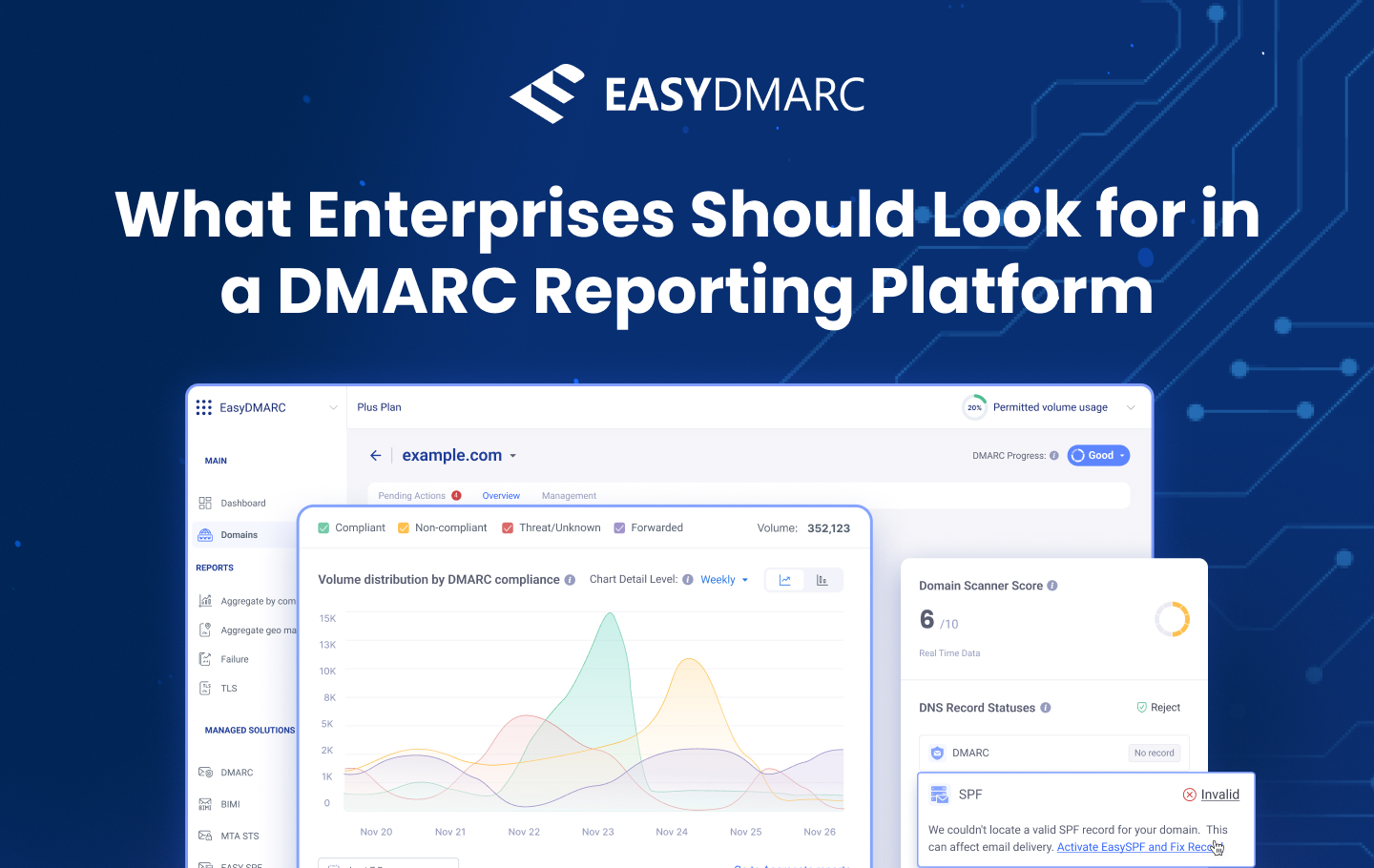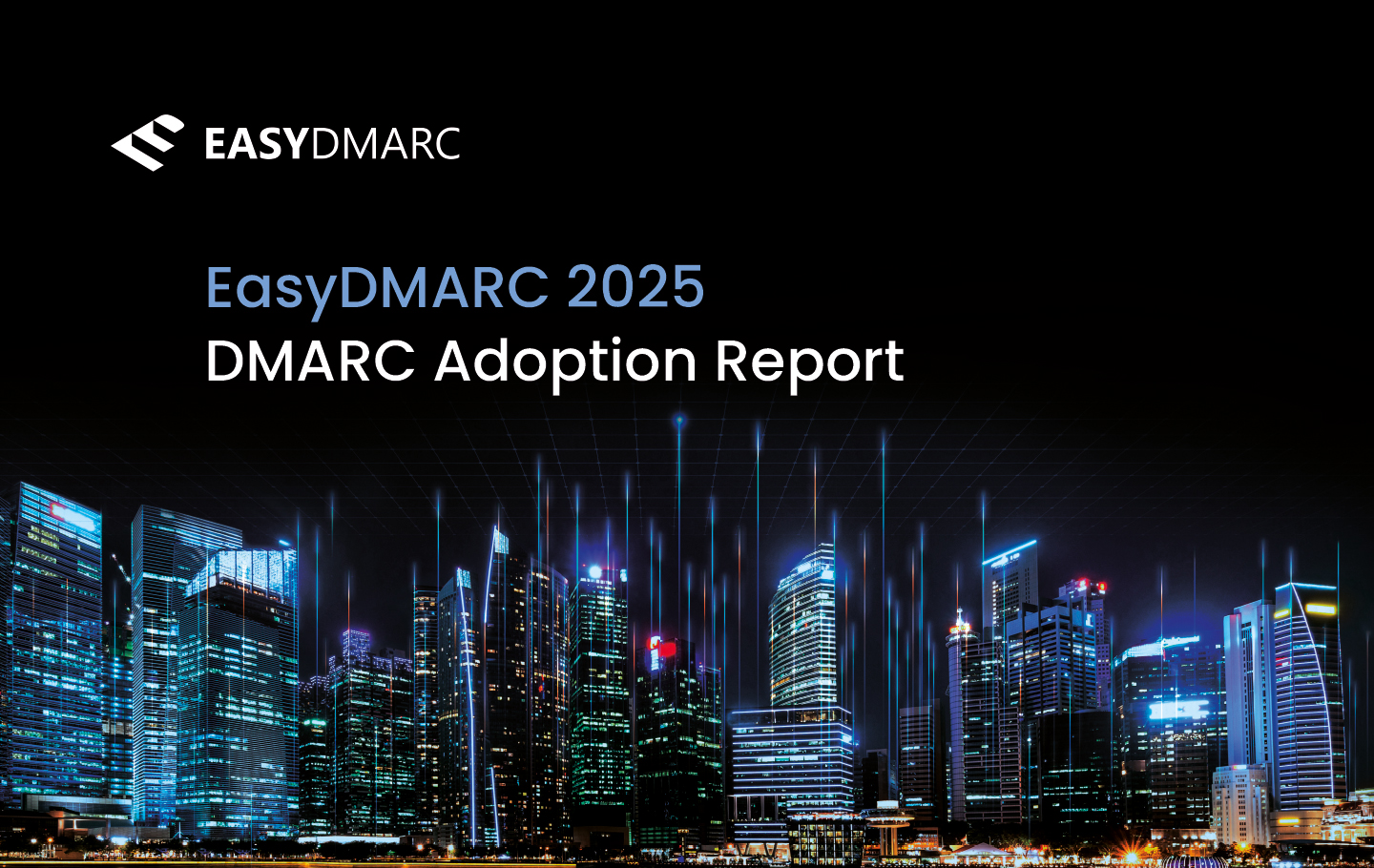Email security has never been more critical for enterprises. In 2025, phishing emails, spoofed domains, and business email compromise (BEC) remain some of the most common ways attackers trick employees and customers. Beyond financial loss, one successful attack can damage a brand’s reputation and make people lose trust in its emails.
This is why many organizations now rely on DMARC, a standard that works alongside SPF and DKIM to confirm that emails are really coming from approved sources. DMARC is largely considered necessary in 2025 because it helps your messages reach inboxes safely while blocking harmful attempts.
Yet having a DMARC policy in place is only the first step. What truly makes it useful at an enterprise level is the reporting platform behind it. A strong DMARC report analyzer platform provides the visibility teams need to see who is using their domains, where failures occur, and how to respond quickly. It also fits naturally into broader email security practices, giving enterprises confidence that their communication channel remains safe and reliable at all times.
Why DMARC Reporting Matters for Enterprises
Enterprises deal with enormous volumes of email each day, ranging from internal communication to external communication for clients and partners. Every message reflects the company’s reputation, so when attackers spoof domains to send fake emails, the impact can be serious. Unlike phishing messages that reach the inbox, many of these threats occur behind the scenes and remain invisible without proper monitoring. DMARC reporting closes this gap by giving enterprises a clear view of how their domains are being used across the internet.
Reporting also plays an important role in meeting compliance requirements. Industries like finance, healthcare, and government face strict rules for protecting sensitive information, and DMARC data provides the evidence needed to demonstrate secure practices during audits or regulatory reviews.
At the same time, these insights guide teams as they adjust their DMARC policies, so the shift from monitoring to full enforcement happens smoothly. By combining visibility, protection, and compliance support, DMARC reporting becomes a cornerstone of enterprise email security and a practical tool for building trust with every message sent.

Key Features to Look for in a DMARC Reporting Platform
A DMARC reporting platform should make complicated data easy to understand and help teams stay in control of all their domains. Here are some of the most useful features to look for when choosing the platform.
1. Aggregate and Forensic Reporting
Aggregate reports (RUA) show the big picture of how emails are performing across all domains. DMARC forensic reports (RUF) zoom in on single messages that fail checks. Together, they make it easy to see which sources are safe, which look suspicious, and where problems need attention. With visual dashboards, teams don’t have to dig through raw data. They can understand the results at a glance.
2. Real-Time Alerts
Instead of waiting days to find out about issues, real-time alerts send instant warnings when something goes wrong. If there’s a spoofing attempt or an email fails authentication, the team knows right away and can act before the problem spreads further.
3. Automated DNS Record Checks
Managing DMARC, SPF, and DKIM records by hand is time-consuming and easy to get wrong. Automation handles the routine checks, finds errors, and confirms that everything is set up correctly. This cuts down on mistakes and saves time for the security team.
4. Multi-Domain and Multi-Tenant Support
Large organizations often manage hundreds of domains, sometimes spread across different regions or business units. A good platform pulls all of them into one dashboard where teams can group, filter, and organize as needed. Multi-tenant support makes it just as simple to oversee client accounts or separate branches of the company.
Scalability and Multi-Domain Management
Managing one or two domains is simple enough, but large enterprises and managed service providers (MSPs) often need to keep an eye on hundreds or even thousands at the same time. Each one may have different email providers, policies, and records, which makes oversight complicated and time-consuming when handled manually.
A scalable reporting platform solves this challenge by combining all domains into a single dashboard. Centralized views, along with grouping and filtering options, allow teams to organize domains by region, brand, or client. Instead of switching between separate tools or spreadsheets, they can quickly focus on the areas that require the most attention.Scalability also prepares organizations for growth. As new domains are added or business units expand, the platform should keep pace without slowing down or becoming harder to use. Enterprise-grade, all-in-one DMARC solutions like EasyDMARC are designed to handle these large portfolios and make it possible to monitor global domain activity efficiently. When a reporting platform is built with scalability in mind, enterprises gain control over even the most complex domain environments.
Compliance, Privacy, and International Standards
Enterprises that work across different regions face not only security risks but also strict legal requirements. A DMARC reporting platform should be built with these rules in mind and offer DMARC lookup tools, since email data often includes sensitive details about senders and systems.
Compliance begins with how data is stored and handled. Regulations such as GDPR in Europe or HIPAA in the United States require that personal information is protected and kept only in approved locations. A well-designed platform allows organizations to choose where their data is stored, making sure it stays within the regions that match their obligations.
Security certifications and standards also play an important role. Encryption, access controls, and independent audits give enterprises confidence that the platform can be trusted to safeguard valuable data. Beyond protecting information, these measures make it easier to pass industry audits and demonstrate that the organization follows global best practices.
For enterprises, compliance is no longer optional, it’s a central part of email security. Therefore, a reporting platform that respects privacy laws and international standards reduces legal risk and strengthens the trust customers place in every email they receive.
Support and Expert Guidance
Even with the best reporting platform, many enterprises struggle to fully understand the data they receive. DMARC reports can be technical, and not every team has the in-house expertise to interpret them correctly. This makes customer support and access to skilled specialists just as important as the technology itself.
Responsive support means that when problems come up, they get solved quickly without interrupting daily email operations. Dedicated DMARC engineers can walk teams through complex reports, explain what the findings mean, and suggest safe ways to adjust policies.
For enterprises managing large domain portfolios, expert advice significantly lowers the chance of mistakes, speeds up the move toward stronger policies, and strengthens the overall email security approach. DMARC provider with personalized enterprise consulting like EasyDMARC combines technical skill with real-world experience so organizations stay protected even without deep internal knowledge.

The Role of DMARC Reporting in Email Security Strategy
DMARC reporting is not a complete defense on its own, but it is a key part of a strong email security strategy. By decoding complex email activity, it helps enterprises apply and adjust authentication policies more easily. Teams know which senders can be trusted, where adjustments are needed, and how to reduce risks without interrupting normal communication.
Beyond policy enforcement, reporting improves the way emails are delivered. Messages from well-managed domains are recognized as safe and are more likely to reach inboxes, while harmful emails pretending to come from the brand are blocked before they reach customers. This combination essentially strengthens protection against phishing and builds greater trust in the company’s communication.
In short, DMARC reporting connects the technical side of authentication with the practical goals of security and deliverability. It gives enterprises the information they need to make smarter decisions, protect their reputation, and keep email a reliable channel for business.
Frequently Asked Questions
The best practice is to start simple and build step by step. Enterprises should first set up DMARC in “monitor” mode to collect reports and understand how their domains are used. From there, they can fix alignment issues, remove unauthorized senders, and then move toward stricter policies like quarantine or reject. Regularly reviewing reports and keeping DNS records updated is key to long-term success.
Look for a provider that can handle large domain portfolios, offers clear reporting tools, and provides expert guidance when needed. Certifications, data protection standards, and strong customer support are also good signs. A trustworthy provider should make the process easier, not more complicated.
The fastest way to identify email authentication misconfigurations is through reporting and alerts. A good DMARC platform highlights unusual activity, failed checks, and new sources right away, so teams don’t have to search through raw data. Automated DNS checks also help catch errors early, before they cause delivery problems or security risks.


